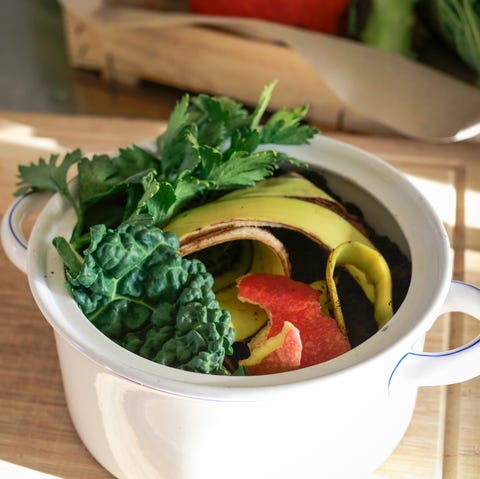How to Make a Compost Pile
Composting not only reduces trash in landfills, but it also increases your backyard at residence. In accordance to the Environmental Protection Company (EPA), “compost is natural and organic product that can be extra to soil to help vegetation develop.” That signifies bigger develop, prettier bouquets and a healthier backyard can occur at no excess expense to you at the time you start out saving your family’s scraps and turning them into “plant foods.”
Adhere to our tutorial to composting so you can support make improvements to the planet — and your own residence backyard garden — whilst lessening the amount of garbage you toss absent. Authorities from the Excellent Housekeeping Institute share their recommendations and tips for generating composting function no make any difference the place you stay.
Why should really I compost?
Composting is an efficient way to lower the volume of rubbish your spouse and children sends to the landfill. Not only does this cut down the methane gas generated by landfills, which is a important variable in world-wide warming, but it can also assistance command trash can odor in your home. And the greatest payoff? You are going to be remaining with a prosperous fertilizer you can use in your have yard or donate to your favourite bring about.
What can I compost?
Foods scrap and property squander might be the greatest per cent of your compost substance — you can include things like a whole lot of products from your kitchen and yard. But other home merchandise, like newspaper and hair, are also fine to incorporate to the mix.
✔️ Foods
- Fruit and vegetable peels and scrap
- Mushroom scraps
- Eggshells
- Bread, grains and pasta
- Espresso grounds and some coffee filters
- Free teas and tea baggage
✔️ Yard
- Grass
- Leaves
- Wooden ash
- Sawdust
✔️ Other
- Newspaper
- Cardboard
- Dryer lint
- Hair
- Nail clippings
- Brown paper baggage
- Toothpicks
- Matches
- Slice bouquets
What can I not compost?
Although they are biodegradable, dairy or animal products (even animal bones) will start to smell and catch the attention of pests, so toss individuals in your outdated-college garbage can. The identical goes for fats, oils and pet waste. Also, if you have a illness or insect ridden plant, do not incorporate it to the pile — it could contaminate your compost, generating it unusable.
✔️ Food items
- Meat or animal bones
- Dairy
- Egg whites or yolks
✔️ Yard
- Diseased leaves or crops
- Coal ash
✔️ Other
- Grease
- Substances
- Pet squander
- Create stickers
- Plastic
- Fats and oils
This articles is imported from embed-identify. You could be equipped to find the identical material in a different format, or you could be in a position to discover far more information, at their world wide web web-site.
How can I compost outside?
If you want to compost in your backyard, study the dos and don’ts to set on your own up for success. Selen Nehrozoglu, a analysis assistant at the New Jersey Agricultural Experiment Station in New Brunswick, NJ, shared her useful suggestions on how to regulate your natural waste:
- Produce a compost zone. If you prepare to use a compost bin, make positive it’s effortless to obtain and that there is area for a lid to open up. Nehrozoglu states it is great to use any sealable containers for each indoor and outdoor compost storage. “For indoor compost, containers with lids that twist shut have worked properly in my knowledge,” she says. “They are uncomplicated to open up and near although also keeping the scent contained.”
If you want to commence a compost pile, select an open up area—you want at minimum 3 square feet of space—and scatter some twigs or straw to make certain aeration and drainage. Use rooster wire or fencing to safeguard your pile from animals this sort of as raccoons (or even the neighbor’s dog).
- Balance “green” and “brown” supplies. Irrespective of whether you choose for a bin or a pile, Nehrozoglu claims a beneficial ratio for compost composition is roughly two-thirds “brown matter” (sticks, dry leaves, or dirt) and a single-third “green matter” (food items scraps or fresh plant squander). Preserving a stability is important is since “brown” products are prosperous in carbon, feeding the organisms that split down the scraps, and “environmentally friendly” components source nitrogen — vital for developing the cell composition of your new soil.
“As a common rule of thumb, I like to incorporate plenty of brown matter to completely address the food scraps,” she claims. “I use a shovel to blend the components together, chopping down any of the a lot more bulky food scraps like melon peels. Just after mixing, I increase a skinny layer of brown make a difference on prime.”
- Deal with the moisture. If your pile does not receive ample rain, you will want to incorporate drinking water with a watering can or hose. You could also choose to insert soaked scraps when humidity is essential. You are going for damp, not soaking.
If you reside in a extremely wet region, continue to keep the pile lined (a unfastened tarp is great) so it doesn’t get way too moist, which can induce rot and wipe out valuable microorganisms.
- Convert your compost. Your compost also requires oxygen. Without air, your pile will start off to rot and odor, so you are going to will need to rotate and stir the pile. With the proper mixture of scrap, humidity and air, your compost really should odor like practically nothing but earthy grime. Nehrozoglu suggests that for handbook mixing — use a pitchfork— you’ll ideally transform the scraps every two to four weeks.
If you’re employing a bin, you could choose for a tumbler, which spins to combine the compost. Some also incorporate an internal rail that breaks up the compost to aid with aeration. With a tumbling bin, abide by the manufacturer’s suggestion. Most advise spinning your bin just about every two to 3 times.
When turning the compost, check out for heat. The heart of your pile or bin need to experience warm you want to manage an inner temperature of 130˚F to 150˚F. When the compost is completely ready, it will stop generating warmth and search uniform and crumbly, like soil.
How can I compost inside?
Regardless of whether you are in an condominium or a dwelling without the need of a backyard, you can set up a mini selection station appropriate in your kitchen so you really don’t have to trash meals scraps. See underneath for a step-by-move information from the gurus at the Good Housekeeping Institute:
- Get a compost bin with a tight-fitting lid. Whether you decide for a plastic bin or a stainless steel version, make absolutely sure it arrives with a lid. Some plastic versions may take in smells, explains Laurie Jennings, GH Institute director, which is why she employs an previous stainless steel ice bucket with a matching lid on her countertop to collect compostable material.
- Line your compost bin with biodegradable bags. Though it’s tempting to want to reuse plastic bags from the grocery store, these are not biodegradable and can defeat the function of your composting. Jennings swears by BioBag’s compostable bags (accessible in 3- and 13-gallon dimensions) even immediately after seeking a range of far more costly brands.
- Keep comprehensive compost bags in your freezer. You can expect to want to replace the bag regularly so months-aged scraps will not get started to stink up your space. After your bin is at ability, secure the bag, and spot it in the freezer (indeed, genuinely!). This will make scraps less complicated to transport, remove any odor, halt energetic decomposition and invest in you some time if you can not promptly get rid of them.
- Obtain a nearby collection services or drop-off site. If you really do not have a back garden in which to compost your scraps, see if your group provides assortment companies. Contact your neighborhood municipality or stop by CompostNow’s web site which lists taking part solutions all-around the nation — some even present at-property starter kits and typical curbside pickup. The regulations all rely on wherever you live. If you provide your possess squander to a transfer station, verify with them also: A lot of have selected compost areas.
If you are living in an apartment or in a city without the need of assortment, you likely have to put in a minor more hard work to donate your compost, but it is well worth it, explains Birnur Aral, Ph.D., director of the Health and fitness, Attractiveness & Environmental Sciences Lab, who is a household-composter in a local community that doesn’t have a collection method.
“Every handful of weeks I provide my scraps to my daughter’s higher education where they have built a composting bin,” she claims. “In the summer time, I carry baggage to my neighborhood farmer’s market place and give them to a neighbor who sells make and works by using the compost at her farm upstate.” It can be a very little way to give back again.
How can I use my compost?
Integrate it into your garden beds or sprinkle it on prime. Don’t forget, compost is not a alternative for your soil, but alternatively acts as a natural fertilizer to nurture your soil and plants, so insert it a couple of situations a year for most effective outcomes.
This content is created and taken care of by a 3rd occasion, and imported on to this webpage to help end users deliver their e mail addresses. You may possibly be in a position to obtain much more information and facts about this and similar material at piano.io




/cdn.vox-cdn.com/uploads/chorus_asset/file/19624303/edited_LRB_110812_6348_2.0__1_.jpg)



